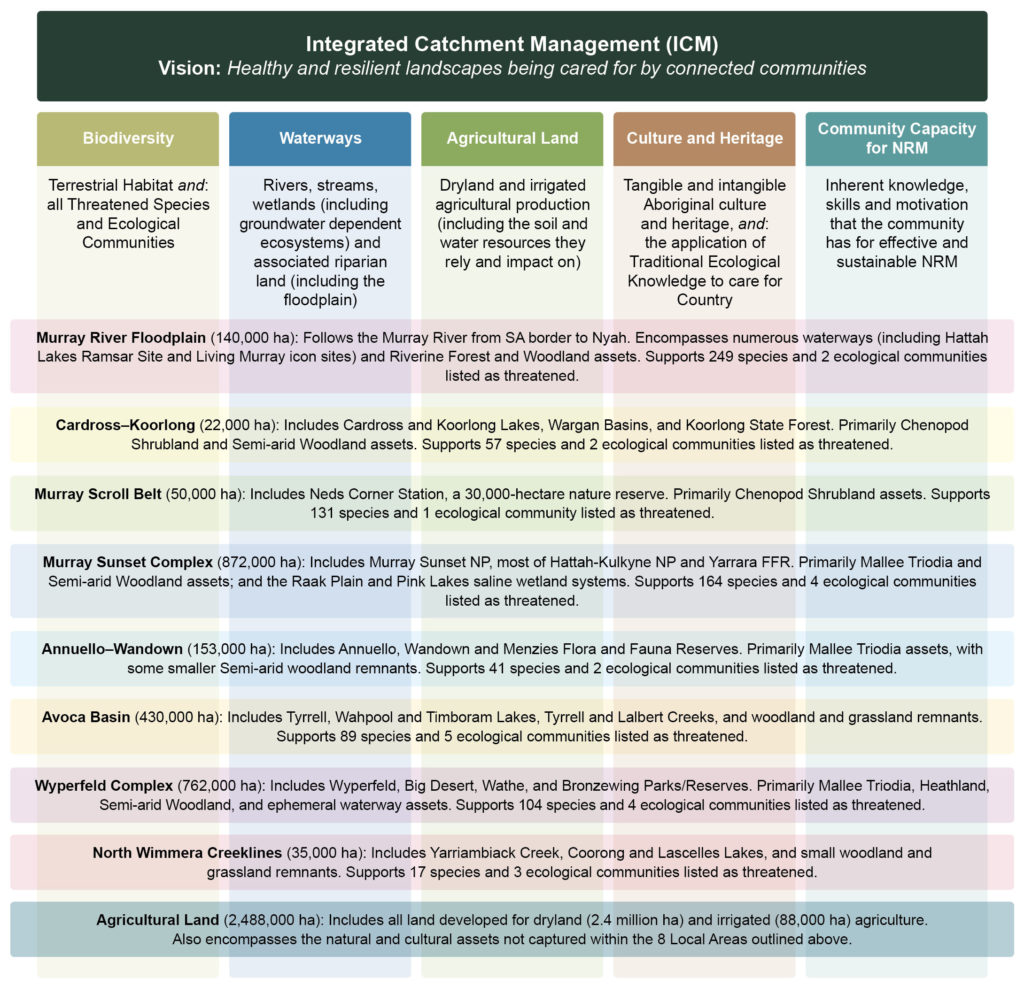The Regional Catchment Strategy is the primary integrated planning framework for land, water and biodiversity in each of Victoria’s ten catchment management authority regions.
Developed in partnership with regional NRM stakeholders, the RCS provides a six-year framework for strategic action to support and focus the ongoing coordinated efforts of the region’s land managers, Traditional Owners, industry and community groups, and government agencies.
The RCS is prepared under provision of the Catchment and Land Protection Act 1994 (CaLP Act), which sets the overall purpose of the strategy as being:
- To establish a framework for the integrated and coordinated management of the catchment which will;
- a. Maintain and enhance long term land productivity, while also conserving the environment
- b. Aim to ensure that the quality of the state’s land and water resources and associated plant and animal life are maintained and enhanced
- To establish processes that can be used to assess the condition of the state’s land and water resources and the effectiveness of land protection measures
- To establish processes to encourage and support participation of landholders, resource managers and other members of the community in catchment management and land protection.
Guidelines, produced by the Victorian Catchment Management Council (VCMC), provide the framework under which the 2022–28 RCS was developed; incorporating the overall principles of:
- An integrated catchment management (ICM) approach
- Regional ownership, embracing the regional delivery model, including co-delivery from committed partners
- A place-based systems approach, at regional and local levels
- Building on strong community engagement and stakeholder partnerships
- Regard for Aboriginal cultural values and traditional ecological knowledge
- A triple bottom line approach, including consideration of socio-cultural, economic, and environmental factors
- Being evidence-based, supported by science and defendable data
- Having the flexibility to adopt new technologies and new information as they arise.
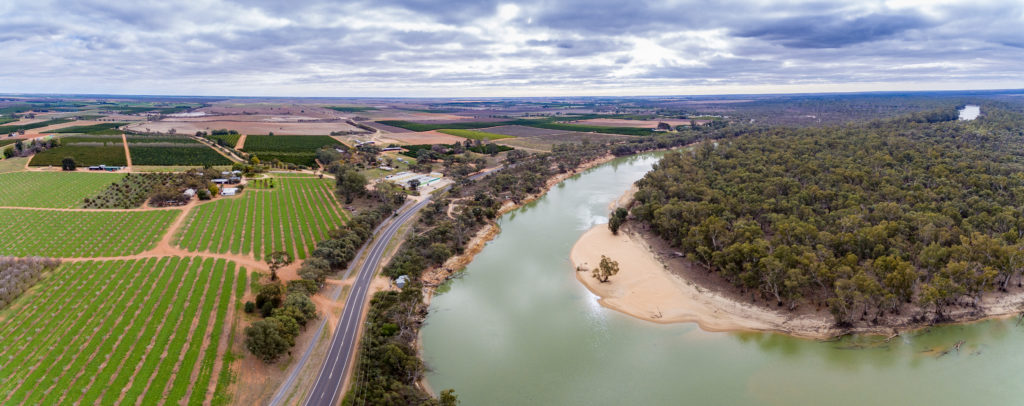
Figure 4 | The Mallee RCS employs an ICM approach by collectively addressing threats to natural, cultural and productive assets at the landscape (Local Area) scale.
The 2022–28 RCS represents the fourth such strategy for the region; building on lessons learnt from the design, implementation and review of preceding documents.
Mid-term and final reviews of the 2013–2019 RCS were undertaken to understand and record the successes (or otherwise) and knowledge that resulted from implementation, and to inform RCS renewal processes. These reviews were based on key evaluation questions (KEQs) established under the RCS Monitoring, Evaluation and Reporting (MER) to provide assessments of impact, appropriateness, effectiveness, efficiency and legacy.
Feedback on the RCS approach, performance and renewal processes was provided through a range of existing forums and targeted events. This included discussions with community, Traditional Owners, industry and government. Determining progress against RCS objectives and the identification of key strategic, policy and knowledge changes was also informed through consideration of the region’s broader evidence base (e.g. Management and Condition Reporting, sub-strategy development and implementation).
Overall, the review identified that the approach applied by the 2013–19 RCS continues to provide an effective framework on which to base the 2022–28 strategy; recommending that subsequent renewal processes focus on testing, validating and (where required) updating the existing framework and associated priorities (i.e. rather than establishing a new framework and associated background material). Individual findings and associated recommendations that informed development of this RCS are outlined in Table 1.
To fulfil its purpose, the RCS sets an aspirational vision for the management of natural, cultural and productive landscapes; the long-term (20-year) and medium-term (6-year) outcomes we seek to deliver through management of assets within these landscapes; and the 6-year strategic actions required to achieve these outcomes.
The concept of assets is fundamental to NRM in the Mallee. Our assets are the biophysical elements of the environment that give our region significance, substance and meaning to both the local and wider community.
Each asset has its own significance which is derived from a complex combination of environmental, cultural, social and economic values that are attached to it by society.
The Asset Based Approach (ABA) applied by this RCS examines an asset’s significance against the level and trend of risks to ongoing asset condition, and the capacity and likelihood of effectively mitigating against those risks. This allows for the identification and prioritisation of interventions intended to protect or improve the condition of an asset in accordance with stakeholder expectations.
This RCS applies two scales (whole of region and local landscapes) at which these asset x risk x intervention interactions are considered.
Regional assets
The RCS groups the key elements of our natural, cultural and productive landscapes that apply at a whole-of-region scale into five themes; Biodiversity, Waterways, Agricultural Land, Culture and Heritage, and Community Capacity for NRM. The definitions applied by the RCS to each theme are provided in Table 2.
Section 3 (Themes) of the RCS outlines: the current condition of assets within each theme; factors influencing change in condition; priority directions for the future management of assets; the key federal, state and regional planning instruments informing these priorities; and the outcomes we are seeking to achieve through RCS implementation (i.e. 6-year targets) and beyond (i.e. 20-year targets).
Landscape assets
Landscape assets are spatial boundaries that group our biophysical systems into discrete local areas. These spatial boundaries provide the basis for integrated and targeted action by considering interactions between assets, associated threat processes, and potential management interventions; at a scale that is meaningful to local stakeholders.
As part of RCS renewal processes, landscape boundaries applied by the previous RCS were reviewed with key government organisations, Traditional Owners and community/industry stakeholders to ensure they remain relevant and up-to-date with the most current available data. This included aligning, where appropriate, with complementary planning approaches, such as: Biodiversity Response Planning ‘Landscapes of Interest’, Parks Victoria’s ‘Conservation Assets’; and Mallee Waterway Strategy ‘Waterway Management Units’.
Figure 5A presents the eight discrete Local Areas established through this process: Murray River Floodplain; Cardross-Koorlong; Murray Scroll Belt; Murray Sunset Complex; Annuello-Wandown; Avoca Basin; Wyperfeld Complex; and North Wimmera Creeklines. Each of these Local Areas represent a social-ecological system within which stakeholder priorities and interests can be captured, and interactions between natural and cultural assets highlighted.
It is also recognised that there will be cross-landscape connections across these Local Areas, with boundaries intended to inform planning and reporting processes; rather than as a means to separate management approaches and delivery partnerships. Providing for whole-of-landscape connections will also be integral to addressing a key point of concern raised through Traditional Owner consultation. Specifically, that the application of discrete Local Area boundaries doesn’t support holistic management of Country as ‘cultural landscapes’ (see Section 3.4 for further detail regarding management directions and priorities for the application of cultural landscapes within the RCS delivery framework).
Sub-management units have also been identified for some Local Areas to recognise asset groupings/ commonalities within the larger landscape, enabling associated planning and delivery processes to be undertaken at the appropriate scale (see Section 4).
Within this framework, dryland and irrigated agricultural land are considered dispersed landscapes with similar threat x management intervention interactions at
the whole-of-region scale. Spatially delineating and considering them within each of the individual local areas would create inefficiencies in planning and delivery; and require significant replication regarding the documentation of associated values, threats, priorities and delivery partners within each Local Area. Agricultural land is therefore presented separately as an additional, dispersed Local Area (Figure 5B).
Priority bio-link corridors established by the Mallee Natural Resource Management Plan for Climate Change (2016) have also been incorporated into the Agricultural Land Local Area to support improved connectivity within this fragmented landscape and enhance natural pathways for wildlife movements; aiding species’ dispersal for climate change adaptation. These corridors were identified as the most effective locations to enhance linkages between the region’s significant ecological landscapes (i.e. Local Assets).
Section 4 (Local Areas) of the RCS provides an overview of each Local Area, describing: significant values, major threats, priority management direction, medium-term (6-year) management targets, and potential delivery partners.
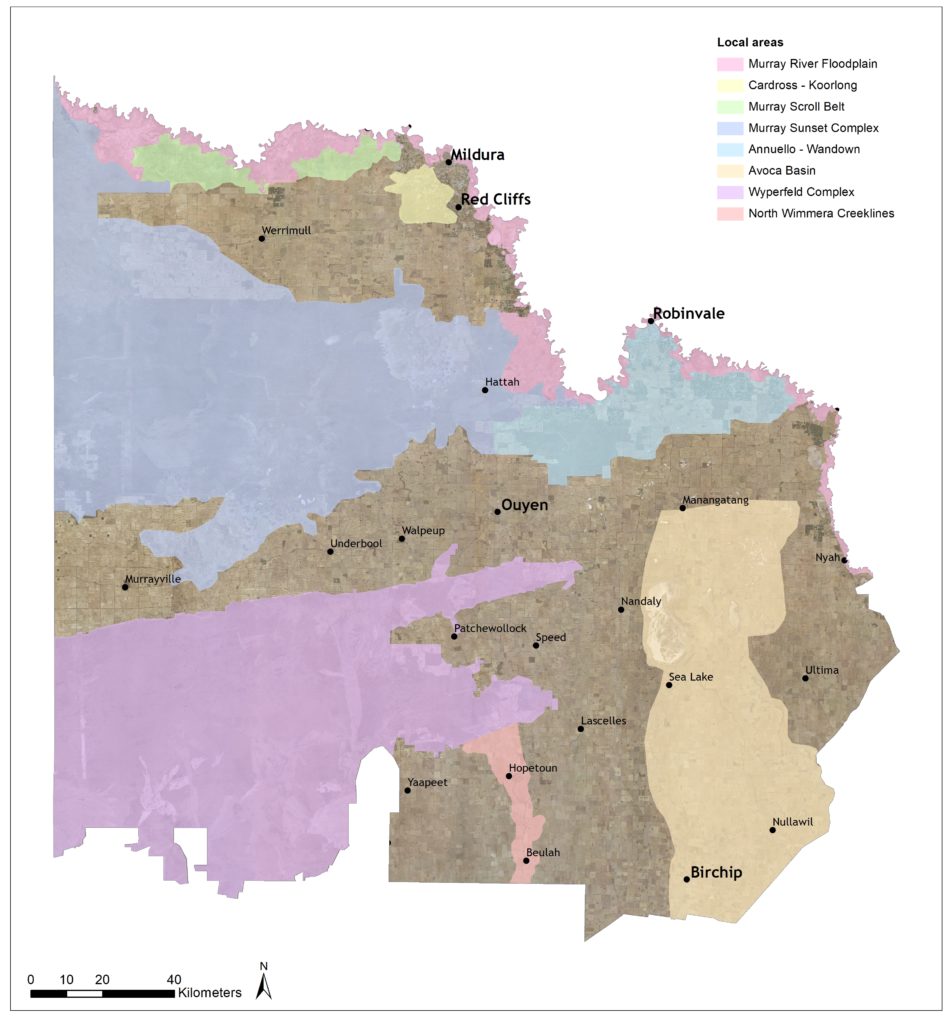
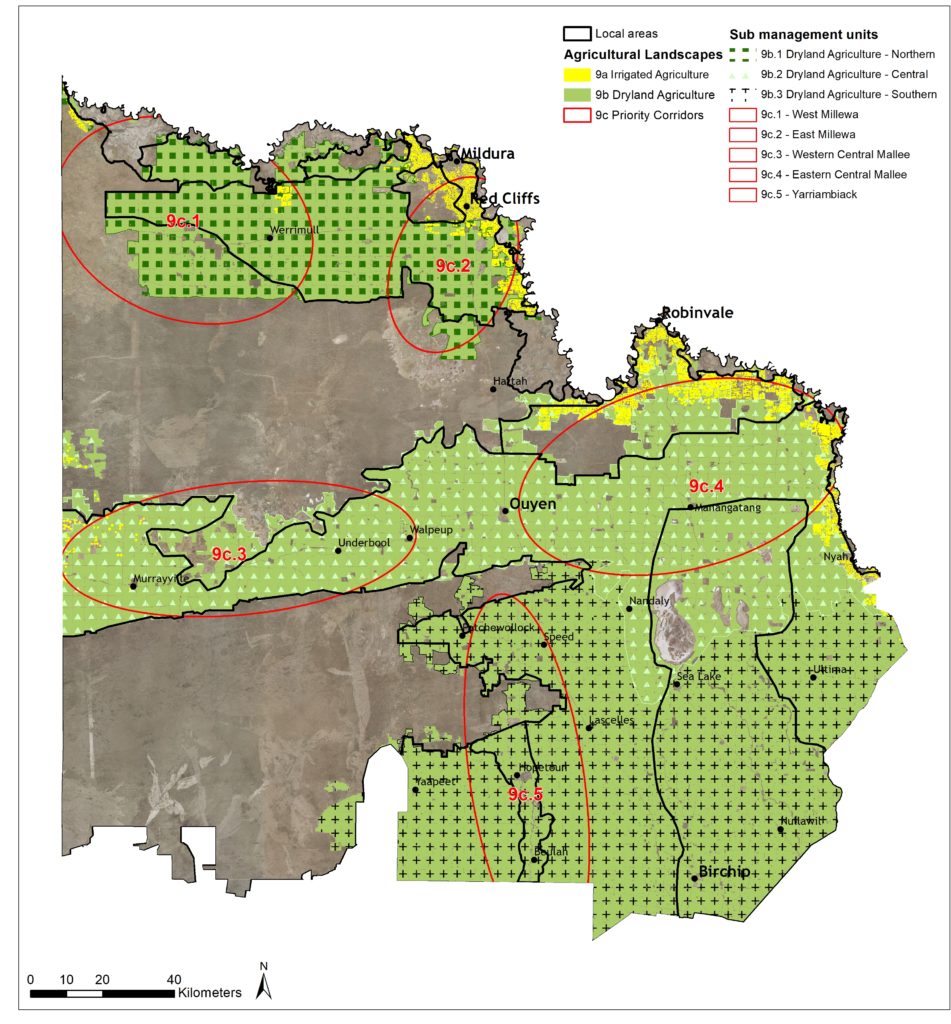
Figure 5 | Local area boundaries established by the RCS encompass; A – Discrete groupings of ecological landscapes boundaries; and B – Dispersed irrigated and dryland agricultural landscapes; and priority corridors (bio-links) for the re-establishment of native vegetation.
Development of the RCS has primarily been informed by four key means, federal and state legislation, policies and strategies; regional strategies and action plans; landscape scale plans; and the Mallee community.
Strategic framework
The Mallee RCS sits within a complex regulatory and policy framework that informs its development and which in turn gives it purpose and effect. By considering the relevant components of this framework in the identification of regional and landscape scale priorities, outcome targets and strategic management actions; the RCS provides a key mechanism for translating state and federal objectives into regional outcomes.
Key regional and local planning documents have also been integrated into the RCS development process to capture existing commitments and priorities developed through comprehensive stakeholder input.
Figure 6 provides an overview of the relevant federal, state, regional, and local legislation, policies, strategies, and plans which have informed the development of this RCS. A full listing of the key instruments considered throughout the RCS renewal process is provided in Appendix 2.
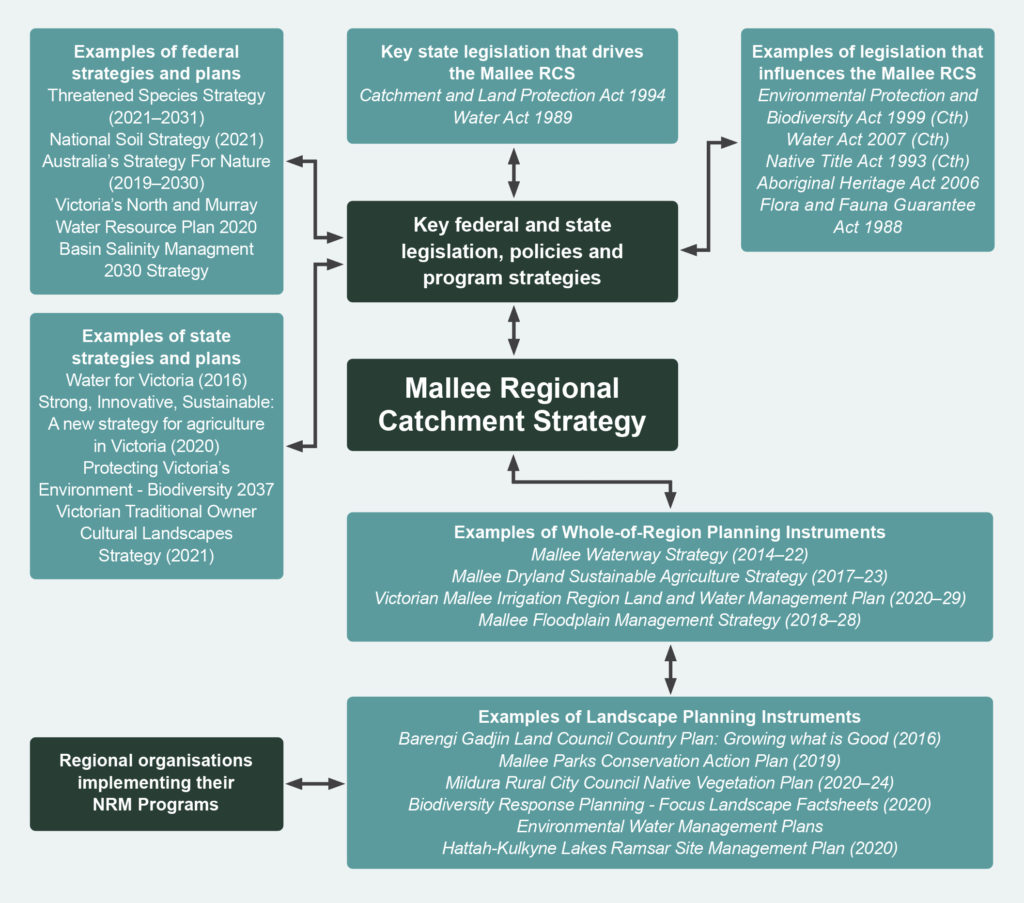
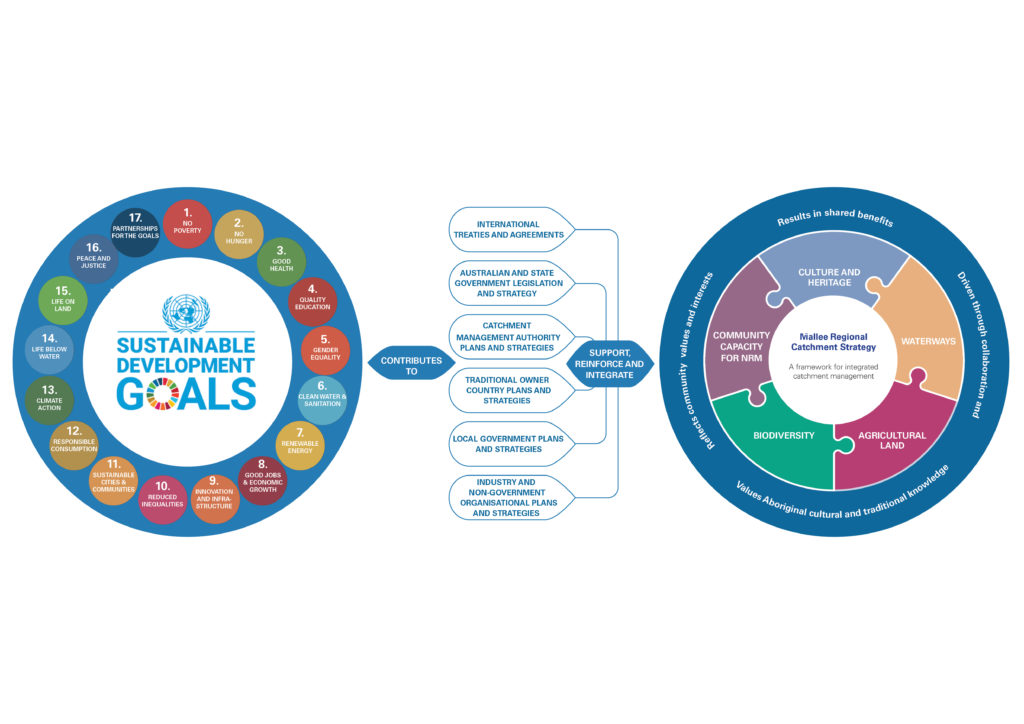
Implementation of the RCS also contributes to several international plans and agreements. This includes delivery against United Nations (UN) Sustainable Development Goals adopted by all United Member States (193 countries) in 2015 as a global framework for sustainable development to 2030.
Under the framework, environmental, social and economic development are indivisible, with the overall aim of: reducing poverty and inequality; promoting prosperity and well-being for all; protecting the environment and addressing climate change; and encouraging good governance, peace and security.
Figure 7 demonstrates how collective action at the local level (i.e. RCS implementation) supports delivery against sustainable development at the global scale.
Community engagement
The success of this RCS is dependent on meaningful and ongoing engagement with all regional delivery partners and stakeholders. Capturing the aspirations, knowledge, priorities and expectations of the region’s land managers, Traditional Owners/First Peoples, community-based NRM/industry groups and individuals throughout the RCS development phase is a fundamental component of this process.
Figure 8 provides a summary of the communication and engagement framework employed by RCS development processes. Key engagement activities conducted under this framework included targeted (i.e. RCS specific) workshops, On-Country events, online surveys, email updates, social media posts, website updates and general promotions at regional events (e.g. field days).
Issues, priorities and interests identified by local stakeholders through broader (i.e. non-RCS specific), program-based engagement activities (e.g. workshops, on Country events) were also collated and considered to inform the RCS development.
Appendix 3 provides further detail on activities delivered and the stakeholders engaged throughout the RCS development phase.
Through this engagement, a broad cross-section of the Mallee NRM community have provided valuable input into:
- Identifying regional and local scale strategies and plans to assist in identifying existing commitments and priorities
- Identifying the key drivers influencing Mallee NRM, including; new and emerging challenges and opportunities, and key threatening processes
- Reviewing asset groupings to form five Themes under which RCS implementation will be measured and reported at the whole-of-region scale
- Establishing medium-term (6-year) outcome targets for each Theme, and the indicators against which progress will be measured
- Identifying priority directions for the management of regional assets
- Reviewing Local Area boundaries to group regional assets into eight discrete landscapes
- Establishing management targets for each Local Area
- Identifying culturally important and/or locally significant values occurring within individual landscapes
- Identifying existing management programs and future investment priorities for Local Areas
Engaging land manager, Traditional Owner, community, industry and technical representatives in RCS development and decision processes also provided for multiple benefits; both to the information captured within the strategy and to increasing cross-stakeholder awareness of local issues, priorities and challenges.
A draft of the RCS was released for public comment in May 2022, and opportunities to provide feedback widely promoted. Comments were received on the draft at targeted workshops, written submission, and personal communications (e.g. telephone calls). This final RCS has taken account of all comments and feedback received throughout the consultation period.
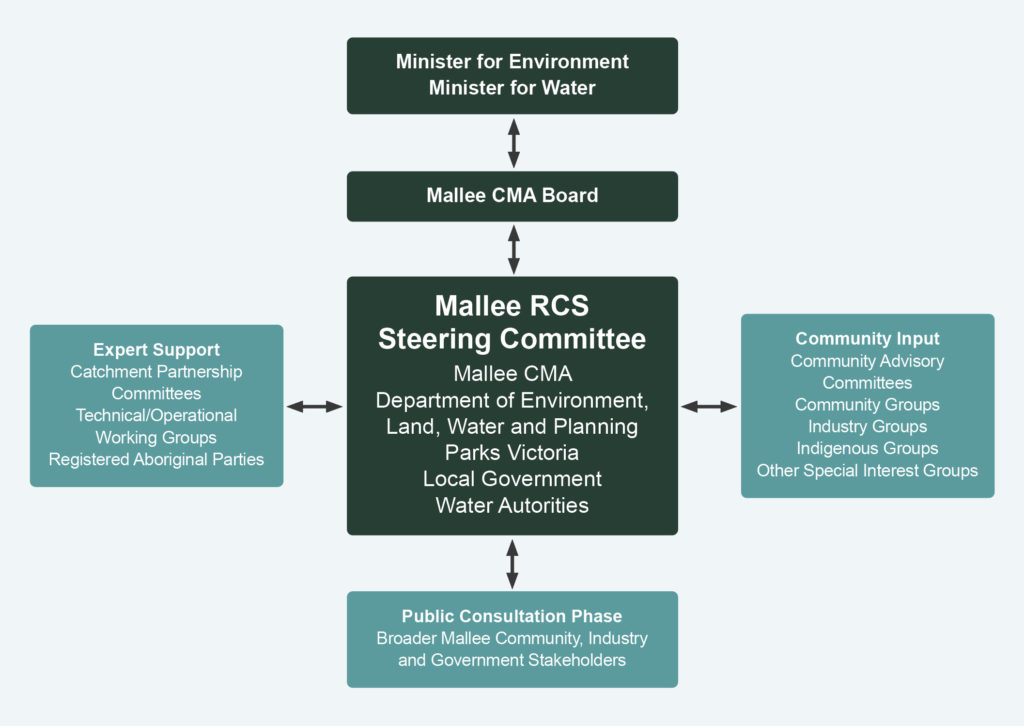
The RCS is based upon the following long-term (50-year) vision for ICM in the Mallee: Healthy and resilient landscapes being cared for by connected communities
Long-term vision (50-year) and outcome (20-year) statements are also identified for each of the RCS regional themes (Biodiversity, Waterways, Agricultural Land, Culture and Heritage, and Community Capacity for NRM) to help us to look beyond our immediate work programs and practical tasks; reminding us of where we are going and what we want to achieve.
Medium-term (6-year) outcome targets are also set for regional themes to provide a means by which RCS contributions can be measured (e.g. effectiveness, impact) at the whole-of-region scale. Management targets detailed for each Local Area identify the integrated (landscape-scale) actions to be delivered over the life of the RCS that will collectively provide for progress against desired outcomes for the region.
Delivery against the RCS’s long, medium and short-term goals is underpinned by several guiding principles, specifically that:
- Community engagement and the involvement of land managers is crucial to the effective implementation of management actions
- Recognising traditional ecological knowledge, through self-determined application of cultural practices, will provide for ongoing ecological ecological benefits and enhanced connections with Country
- Prevention of ecosystem damage and species’ decline is more cost-effective than rehabilitation and recovery efforts
- Decision making should be based on the best available knowledge and decision support tools, however action should not be avoided solely due to lack of scientific certainty
- Decision making should recognise interactions between natural, cultural and productive assets; and that the management of one component can impact (positively or negatively) on others
- To achieve widespread and sustained improvements in our natural, cultural and productive landscapes; actions should also deliver social and economic benefits to the community
- Actions should be planned at the appropriate spatial and temporal scales, while also recognising resourcing expectations
- Planned actions should be flexible enough to adapt to changing circumstances and/or knowledge
Individual long-term outcome targets are detailed for each regional theme in Section 3 (Themes), and for management targets for each Local Area in Section 4 (Local Areas).
Delivery partners
Implementation of the RCS requires the support of Mallee stakeholders; that is all of the landholders, government and non-government organisations, Traditional Owners, community groups, and individuals who play a role in managing our natural, cultural and productive landscapes. Collectively these stakeholders will be responsible for implementing the actions agreed to in this RCS.
Effective partnerships will support the delivery of priority actions across multiple jurisdictions and scales. The Mallee partnership model is complex, reflecting the diversity of landscapes in which we operate. Broad agreement among the region’s delivery partners regarding their roles in implementing the RCS forms the basis for coordination of effort.
Further detail on RCS delivery partnerships is provided in Section 1 (The Region), while potential collaborations to deliver against priority management actions are detailed in Section 4 (Local Areas).
Framework
A key learning from previous RCS’s is that the strategy must allow for adaptation and refinement of regional priorities and MER approaches throughout the implementation phase. To facilitate adaptive management and continuous improvement processes, the 2022–28 RCS will be supported by a series of resources that inform the overarching strategic document, and act as a flexible and updateable repository of information (Figure 9).
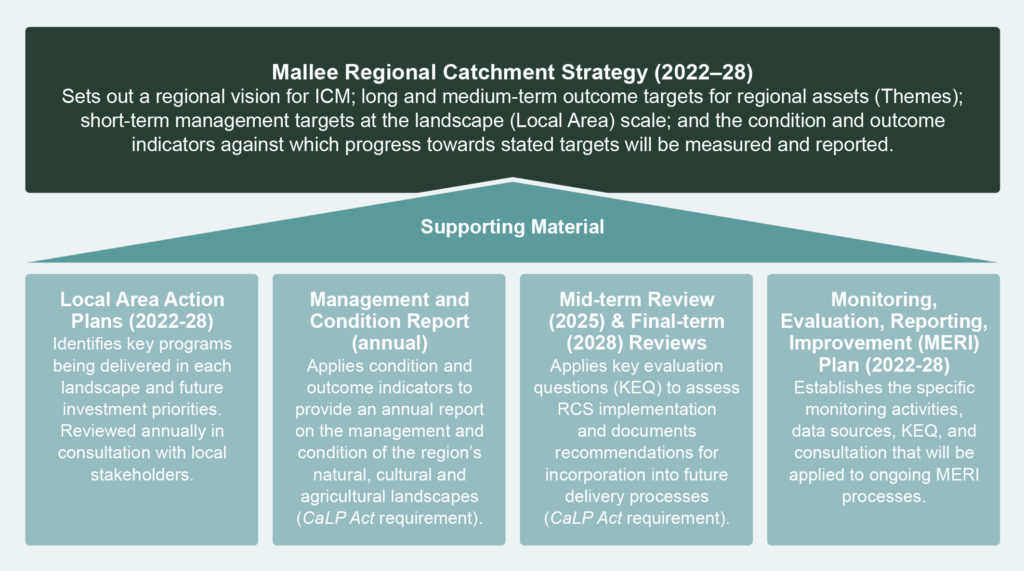
Integrated and targeted management
The long-term condition of our regional assets is often threatened by a common suite of processes. For example, invasive plants and animals, salinity, recreational pressures and wind erosion have the potential to impact on many values within our natural, cultural and productive landscapes. Similarly, actions employed in the management of one asset type can impact (both positively and negatively) on others.
The ‘asset’ focused nature of many funding initiatives can result in programs that address threat processes in isolation, rather than considering asset x threat interrelationships. An approach which can result in duplication and inconsistencies.
Implementation of the RCS will recognise these interrelationships and seek to achieve integrated and multiple outcomes across asset types where possible. This means developing and implementing programs which consider and manage all significant asset types (i.e. Biodiversity, Waterways, Agricultural Land, Culture and Heritage, and Community Capacity for NRM) within a specific landscape, across all land tenures and management arrangements.
Figure 10 presents the regional asset x landscape interactions that will be applied to RCS delivery. Values and threatening processes relating to each of the five RCS Themes will be considered within the nine Local Area landscapes to identify priority management actions that deliver multiple outcomes.
Each of these landscapes present significant diversity in the natural, cultural and productive values they support; and in the processes that threaten their condition. The challenge is how we achieve the ‘best’ results with available resources. The RCS applies a targeted delivery framework to support the delivery of integrated ‘whole-of- landscape’ programs in locations that deliver the greatest environmental, economic, cultural, and social returns on our efforts.
Further detail on how this targeted delivery framework has been applied to regional assets is provided for each of the RCS Themes in Section 3 (Strategic Directions).
